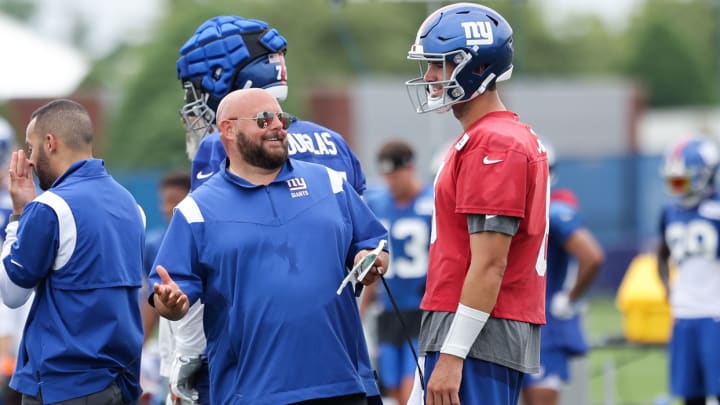How New York Giants Are Trying to Shape Offense into Well-Oiled Machine

In this story:
There’s something very different about the New York Giants offense this year.
Sure, some of the faces are new, particularly on the offensive line and at tight end. And the Giants also picked up a shifty receiver in Wan’Dale Robinson and a solid backup running back in Matt Breida.
But beyond the personnel, the offensive philosophy being run by new head coach Brian Daboll and offensive coordinator Mike Kafka is very different in terms of concepts and schemes.
The biggest sign that this is not your grandfather’s Giants offense is the inclusion of pre-snap motion. Designed in part to help the quarterback get a better feel for if a defense is planning man or zone coverage, pre-snap motion is sort of like the offense’s answer to the defense's amoeba look that masks the exact roles of the players on any given play.
The pre-snap motion isn’t done on every play—sometimes, circumstances don’t allow it. But in certain situations, such as down in the red zone, pre-snap motion can keep a defense guessing what’s coming at them and forces the unit to shift guys around to be in a position to make a stop.
In other words, the days of correctly predicting what the Giants will run and who is getting the ball are over.
"What we’re trying to do is whatever we need to do to help our guys and cause conflicts, issues with the defense," Daboll said.
Based on the feedback from his defensive players who have been going against the offense dating back to the spring, it’s working.
“The offense is showing a lot of diversity, and it definitely confuses defenses,” said defensive lineman Leonard Williams. “I think when you have enough weapons on offense, you allow your offense to have that type of diversity. I think it’s good for the offense.”
Williams said it forces the defense to do more thinking. The pre-snap motion also forces the offense to communicate more to avoid busted plays, which have dotted the first four practices of the summer so far.
"Is it more to learn? Sure, because there’s added calls to it,” Daboll said. “You start on one side and have to be on the other side. You’ve got to start in the backfield and be out here. You know, there’s a little bit of thinking that goes along with it.”
More New York Giants Coverage
- Four Statistical Areas the New York Giants' Offense Must Improve
- New York Giants Mailbag: Training Camp Week 1 Edition
- What We Learned After New York Giants Camp Practice No. 4
Along with the pre-snap motion, another sign that this is not your grandfather’s offense is the tactics deployed in the red zone—motion, crossing routes, and flooding an area with multiple receivers, which almost dares the defense to pick its poison.
Much like in the old Kevin Gilbride offense, the receivers have options for running their routes based on what the defense is showing them.
“It’s more open,” said wide receiver Kadarius Toney, adding that the route-running isn’t ‘as pen and paper” as the last system. “I really enjoy it.”
And it’s designed to boost the scoring production of a team that has finished 31st in the league the last two seasons in average points scored per game.
“You see it out in practice. It forces the defense to think and puts the advantage in our hands. We’ve got to execute on pre-snap, post-snap, and knowing what we’ve got to do because it can be a weapon for us.”
Quarterback Daniel Jones agreed. “I think it gives the quarterback a lot of freedom to take advantage of certain looks to make checks and get the ball to certain guys.”
For the time being, the offense looks more like a disorganized mess than it does a well-oiled, play-making machine. But that’s to be expected at this point in training camp--and that’s what practice is for.
“We are starting to crawl here,” Daboll said of the new offense. “We are making progress, but we’ve got a long way to go.”
Join the Giants Country Community
- Sign up for our FREE digest newsletter
- Follow and like us on Facebook
- Submit your questions for our mailbag
- Check out the new Giants Country YouTube Channel.
- Listen and subscribe to the daily LockedOn Giants podcast.
- Subscribe and like the LockedOn Giants YouTube Channel
- Sign up for our FREE message board forums

Patricia Traina has covered the New York Giants for 30+ seasons, and her work has appeared in multiple media outlets, including The Athletic, Forbes, Bleacher Report, and the Sports Illustrated media group. As a credentialed New York Giants press corps member, Patricia has also covered five Super Bowls (three featuring the Giants), the annual NFL draft, and the NFL Scouting Combine. She is the author of The Big 50: The Men and Moments that Made the New York Giants. In addition to her work with New York Giants On SI, Patricia hosts the Locked On Giants podcast. Patricia is also a member of the Pro Football Writers of America and the Football Writers Association of America.
Follow Patricia_Traina